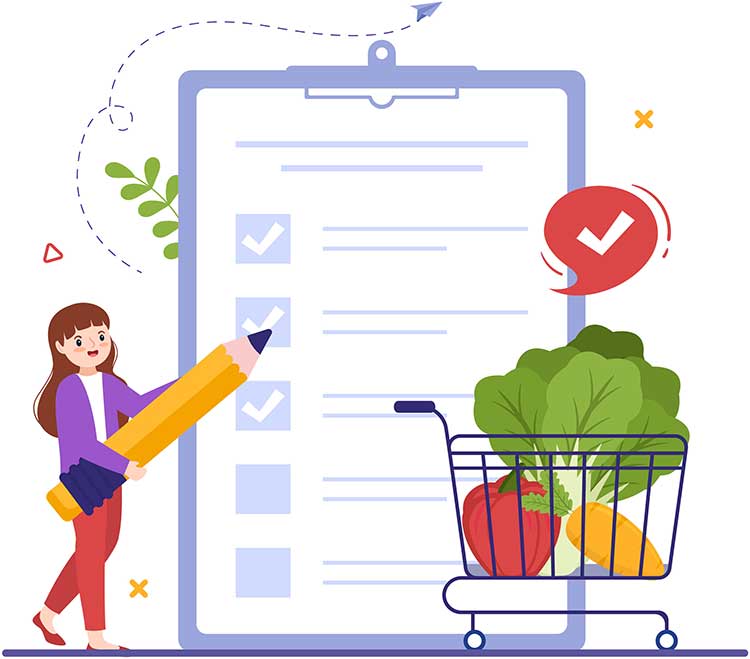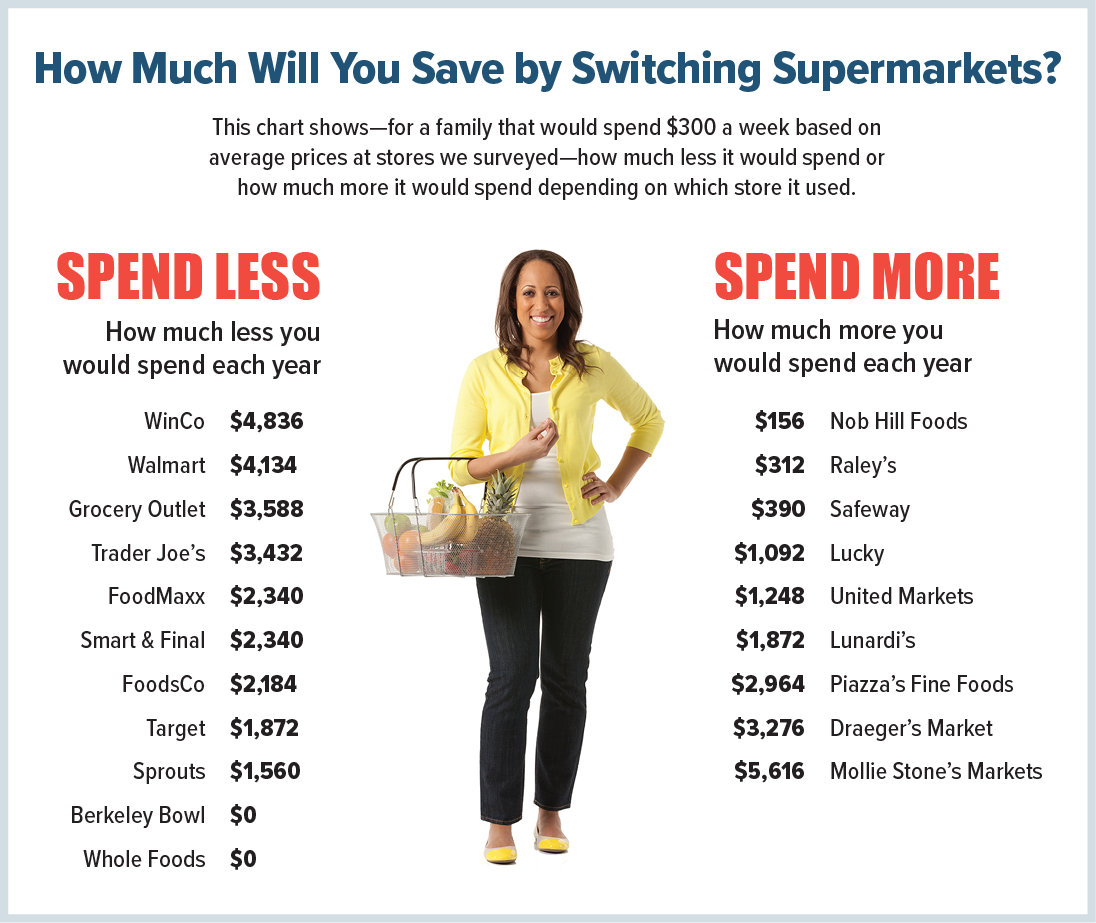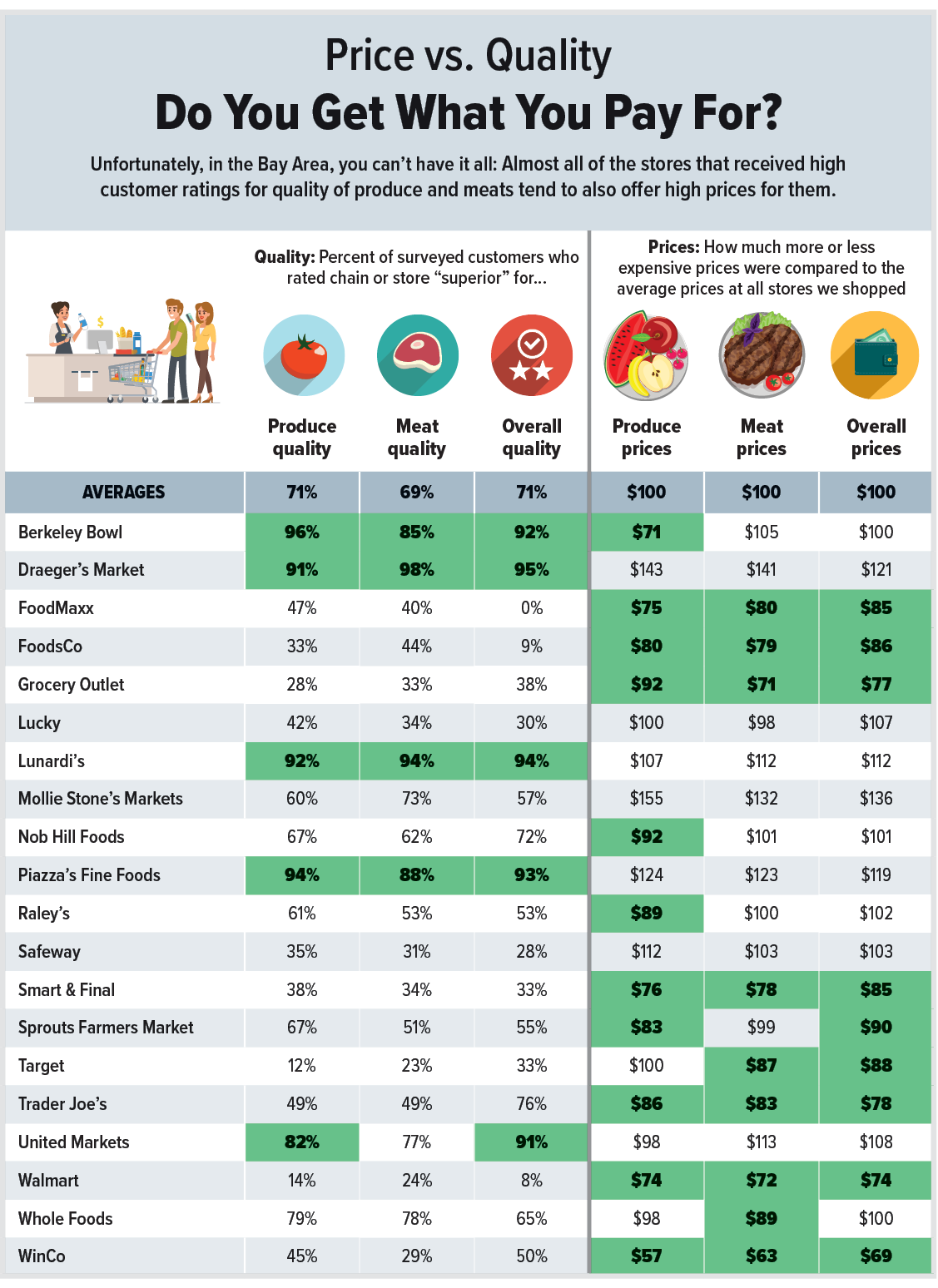Which Grocery Stores Offer the Best Prices and Quality?
Last updated November 2025

Our latest comparison of Bay Area supermarkets’ prices and quality is in the bag. Consumers’ Checkbook researchers shopped stores using a 150-item list to compare prices. To evaluate stores on quality of products and service, we surveyed our members. The figures below summarize our findings; for details, see our Ratings Tables. Here’s what we found:
Enormous price differences among area grocery options, with some stores charging nearly twice as much as others for the same products.
These stark price differences are partially explained by product quality: The chains that received the highest ratings from their surveyed customers on topics such as “fresh produce” and “meats” tend to charge higher prices than the grocery stores that earned poor quality scores. But we also saw enormous price differences when we compared just national-brand nonperishable items, where product quality isn’t an issue (a can of Campbell’s soup is the same no matter where you buy it).
Grocery Outlet, Walmart, and WinCo offer the biggest savings.
WinCo offered prices about 31 percent lower than the average at all other stores we surveyed. Walmart had prices about 26 percent lower; Grocery Outlet, which offers a somewhat odd assortment of steeply discounted surplus national-brand products, offered prices that were about 23 percent lower than average.
For a family that spends $300 per week at the supermarket, a 31 percent price difference totals savings of $4,836 per year.
Other price standouts: FoodMaxx, FoodsCo, Smart & Final, Sprouts Farmers Market, and Target.
Our price comparisons found that all these chains charged prices between 10 and 15 percent lower than the all-store average. Unlike in most other metro areas where we publish Consumers’ Checkbook, most Bay Area shoppers live near at least a few low-cost supermarket options.

Trader Joe’s remains popular—and relatively inexpensive.
Seventy-six percent of survey respondents rated the funky-and-fun chain “superior” for “overall quality.” And TJ’s prices were about 22 percent lower than the all-store average. These savings are partly explained by Trader Joe’s smaller-format stores, which have much lower overhead costs than conventional supermarkets.
TJ’s also benefits from different expectations. Shoppers at Safeway, Walmart, etc., expect to always find their favorite brands on the shelves. But Trader Joe’s carries mostly its own brands, meaning you won’t find Coke, Heinz ketchup, Hellmann’s mayo, and other big names at TJ’s. So, its shoppers don’t expect wide choices of brands or sizes but trade that quirkiness for comparable very-low-priced products. (To account for brand differences, we used a modified market basket to compare Trader Joe’s prices with conventional supermarkets; click here for info.)
For produce, Berkeley Bowl is the lone standout for high quality and low prices.
Its customers raved about its produce quality, with 96 percent judging it “superior.” Berkeley Bowl’s two locations also charge low prices for produce—nearly as low as the prices we found at Walmart.
Unfortunately, the other stores that rate highest for quality charge high prices.
Our members also gave top ratings to Draeger’s Market, Lunardi’s, Piazza’s Fine Foods, and United Markets. But prices at these small chains were considerably higher than other area grocery options.

Prices at Lucky, Nob Hill, Raley’s, and Safeway were about the same.
Lucky and Safeway are owned by the same company, and Raley’s owns Nob Hill Foods. These conventional supermarket chains did little to distinguish themselves from one another on price.
They’re also expensive. Safeway’s prices averaged a whopping 49 percent higher than WinCo, 39 percent higher than Walmart, and 16 percent higher than Target.
On the quality side, the largest grocery chains performed dreadfully.
For our overall quality survey question, FoodMaxx, FoodsCo, Lucky, Safeway, Smart & Final, Target, and Walmart were rated less than “superior” by at least two-thirds of their customers. FoodMaxx, FoodsCo, and Walmart scored lowest—fewer than 10 percent of their customers judged them “superior” overall.
Although the lowest-priced chains received poor ratings for quality, so did Lucky and Safeway, which are far more expensive.
Nob Hill offers higher quality than other conventional supermarkets.
In our surveys of consumers, Nob Hill received significantly higher scores than the other supermarket chains.
Whole Foods’ ratings for quality continue to dip.
When Amazon purchased Whole Foods in 2017, many experts predicted the combination would punish its supermarket competition by combining Whole Foods’ solid reputation with Amazon’s pursuit of distribution perfection. Many consumers hoped they’d pay Amazon-like prices for Whole Foods-quality products. That hasn’t materialized.
Whole Foods built a loyal following by offering high-quality produce, meat, prepared foods, and generic staples. For years it earned high marks in our surveys of consumers, especially for produce and meat quality. Now, Whole Foods’ customers give it far lower scores: On our “overall quality” survey question its score has dropped to just 65 percent.
Our price survey found that Whole Foods’ prices remain just about average among the large chains we shopped—but it did offer slightly lower prices than Safeway.
Among the largest chains, there is relatively little price variation.
Prices at the Lucky, Safeway, and Walmart locations we surveyed were about the same from store to store.
We also checked out savings at Costco, looked at Trader Joe’s, and examined grocery delivery options.
Check out the other articles in our “Grocery Stores” category and our ratings tables for info on all the local grocery options, how we rated them, and tips on saving no matter where you shop.


